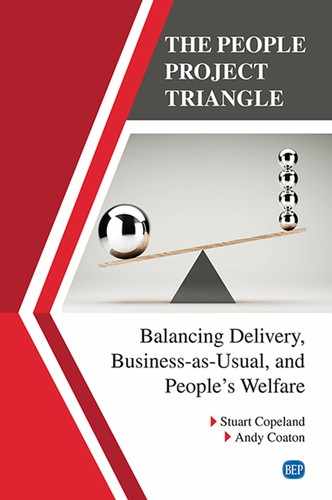Part I of this book charted changes in the business environment over the last few decades and the impact on the project environment.
Part II investigated the implications of these changes with reference to our concept of the people project triangle, on the success of projects, the consequences for the ongoing business, and in particular, the pressure on staff of the modern corporation.
From this, we learned the modern business environment is one of rapid change. The modern corporation is lean and very cost conscious. A consequence is an increasingly common project management situation of a medium important, medium complex business change project that cannot justify a full-time team. Instead, it is largely staffed by in-house resources working on the project in addition to their normal responsibilities. We term these composite projects.
The thesis of the book is that composite projects are being used at an increasing rate to meet the demands of rapid business change. However, they are largely unrecognized as a separate organizational category of project with particular characteristics, management needs, and risks.
Analogous to the classic project Iron Triangle, where there is a trade-off between cost, time, and scope, we maintain that there is a People Project Triangle. This is a trade-off between the project, the ongoing business, and the people working in both the business and the project.
When pressure mounts, generally, only two of those can be prioritized and one must give. We observe that it is often the people who bear the brunt with subsequence implications of stress and burnout.
However, with better recognition, clearer understanding, and appropriate measures, many of the common problems with composite projects can be foreseen and mitigated or avoided.
The remainder of the book, Part III, looks at what to do about it. A framework is provided for identifying when composite projects can be used. Then, a series of chapters recommending practical techniques and approaches for dealing with the implications identified in Part II are provided.
The basis of our recommendations is our own meandering experience, over decades in the field, across varied organizations and sectors. What we say may come across as highly prescriptive, and if this is the case, it is because these approaches have worked for us. However, we recognize this is an under-researched topic, and other managers may find approaches that work better for them and their organization. We hope this is the start of conversation, research, and experimentation into a neglected topic.
We have found several principles, techniques, and ways of working to mitigate the risk of composite projects, and Part III takes you through them covering:
- • How to identify composite projects, and this alone will go a long way in deflecting many problems.
- • The type of support you need before you start.
- • How to make it easier for your project team.
- • How to adapt the methodologies.
- • Practical tips and advice.
